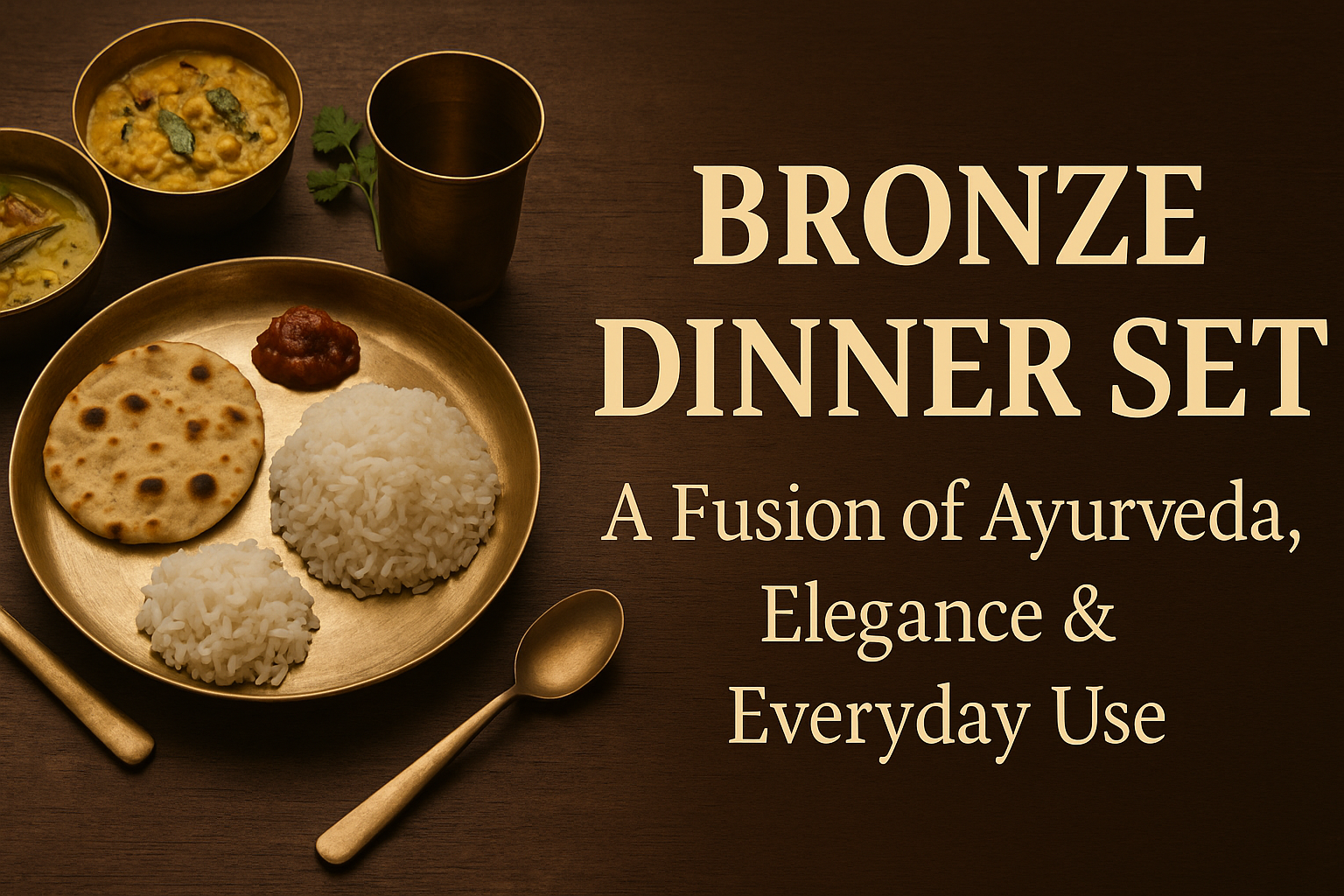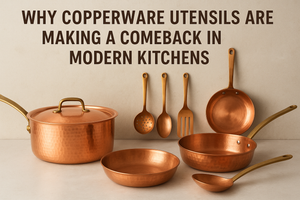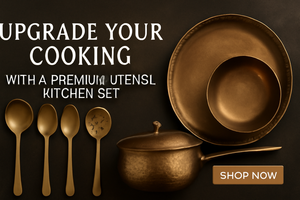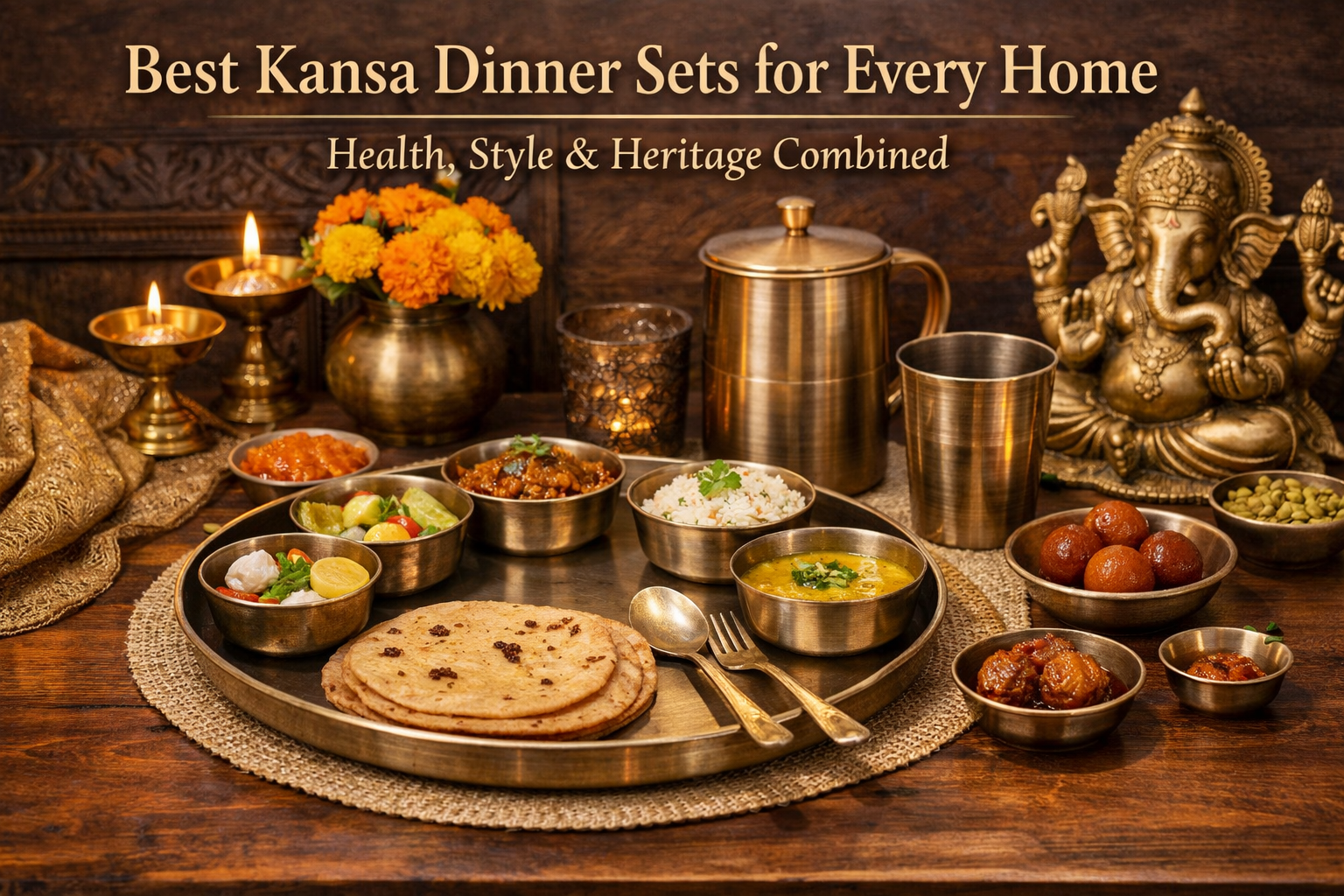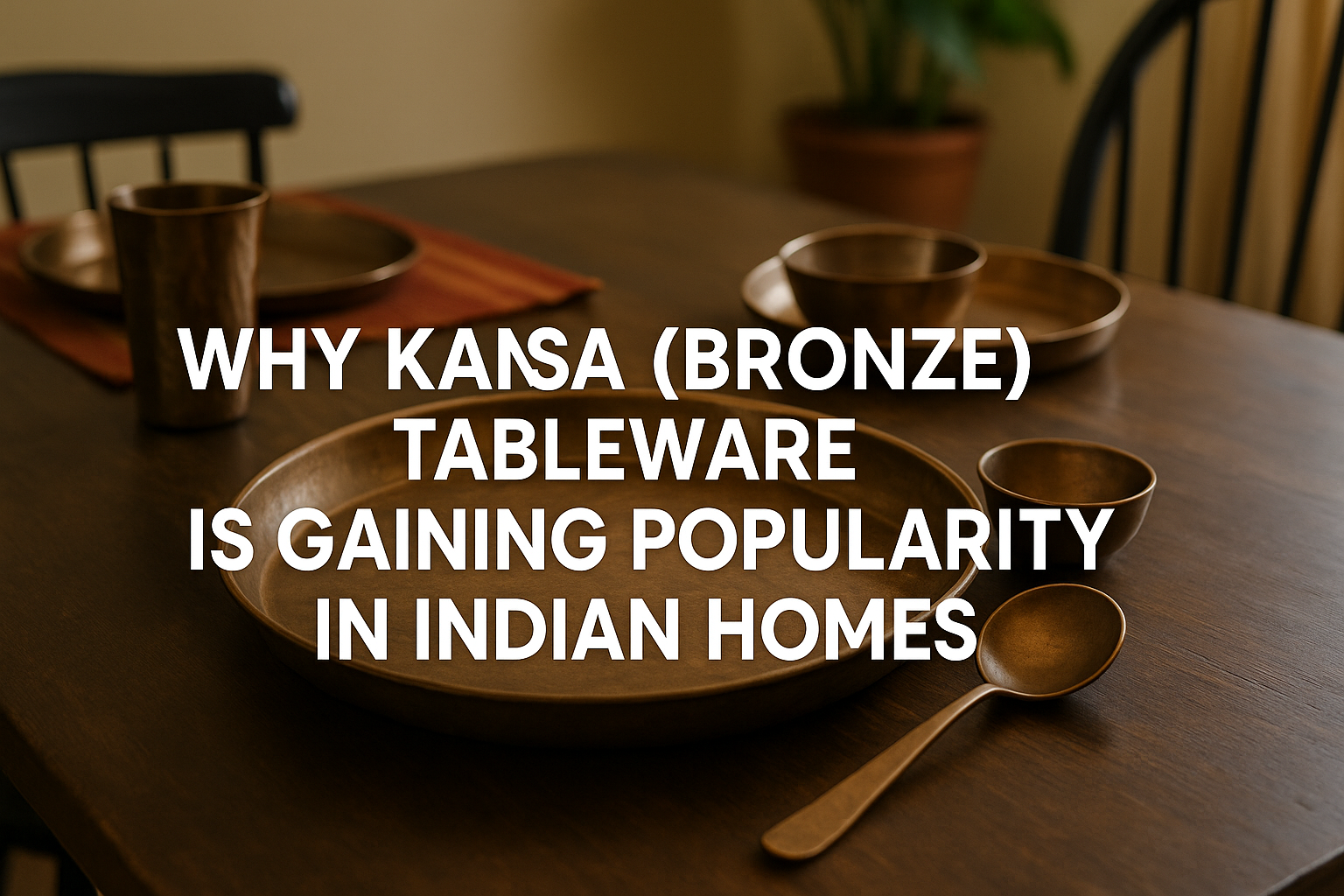Introduction
Imagine sitting down to dinner on a cool evening. The soft glow of warm, earthy-toned bronze plates reflects the light. The aroma of home-cooked food fills the air. There’s something both ancient and elegant about this setting — a bridge between tradition and everyday living.
That’s the magic of a bronze (kansa) dinner set. It’s not just a showpiece: it’s deeply rooted in Ayurvedic tradition, yet perfectly suited for daily meals. In this blog, you’ll discover:
-
the cultural & Ayurvedic heritage behind bronze dinnerware,
-
its potential health & wellness benefits,
-
How to pick a high‑quality set,
-
styling & usage tips,
-
care & maintenance guidelines, and
-
Why the Kansa dinner set from Raj Gharana Metals makes a strong, meaningful choice for your table.
Let’s dive in.
1. The Legacy of Bronze / Kansa in Indian Tradition & Ayurveda
1.1 Historical & Cultural Significance
Bronze, especially the Indian alloy known as “kansa” (roughly copper + tin), has a long legacy in Indian households. In many regions, kansa or bell metal utensils were used for daily meals, ritual dining, and temple worship.
Because of its association with purity, ritual, and longevity, kansa dinnerware was often considered auspicious — even wealth‑symbolizing in homes.
1.2 Ayurvedic Perspective & Philosophy
In Ayurveda, the material of the vessel is more than a container: it interacts energetically with food and the person consuming it. Metals are believed to carry subtle energies.
Kansa (bronze) is traditionally thought to help balance the doshas (Vata, Pitta, Kapha). It is said to pacify excess heat (Pitta) and neutralize acidity, offering a calming, sattvic influence on meals.
While ancient Ayurvedic texts don’t always name “bronze dinner set” explicitly, the broad tradition of using copper, tin, and allied metals in cookware and utensils is well documented.
2. Health & Wellness Benefits of a Bronze Dinner Set
Before going on, it’s important to note: many of the benefits attributed to bronze dinnerware stem from traditional wisdom or preliminary modern studies rather than wide-scale clinical trials. Always use with balanced expectations. That said, these are the commonly claimed benefits:
2.1 Natural Antimicrobial Properties
Copper (a major component of bronze) is scientifically shown to have antimicrobial effects. Surfaces of copper alloys are known to kill many bacteria and pathogens over time.
So serving or storing food briefly in bronze may reduce microbial load compared to some inert surfaces.
2.2 Improved Digestion & Alkalising Effect
Because of its mild alkalinity, it is believed that kansa can help neutralize acidity in food, aiding digestion and reducing reflux or heaviness sensations.
Many traditional users report lighter digestion when eating meals served in bronze.
2.3 Trace Mineral Contribution (Copper & Tin)
A very minute amount of copper and tin may leach into food when in contact. Copper is an essential trace mineral important for red blood cell formation, connective tissue, and immune function.
These amounts are usually too small to cause concern in healthy individuals, but those with copper sensitivities or disorders (e.g., Wilson’s disease) should be cautious.
2.4 Flavor Enhancement & Thermal Distribution
Bronze has decent thermal conductivity and can help keep food warm longer, distributing heat more evenly when reheated or served.
Many users say that flavors feel “sharper” or more vivid when eating from bronze, possibly because interactions between the metal and acidic food subtly affect taste.
2.5 Potential Anti‑Inflammatory & Detox Support
In traditional writings and modern wellness blogs, bronze (copper-rich) utensils are claimed to help with detoxification, reduce inflammation, and support skin and immunity.
While promising, these claims require more rigorous scientific backing.
2.6 Balanced Perspective & Safety Notes
-
Avoid using extremely acidic foods in bronze for long durations, as they can react with the metal.
-
The formation of a natural patina is normal; that doesn’t necessarily indicate hazard.
-
Always clean and dry properly to prevent corrosion or oxidation.
3. How to Choose a Quality Bronze Dinner Set
When you decide to invest in a bronze dinner set, these factors matter:
3.1 Material Composition & Purity
Look for sets that clearly state the copper-to-tin ratio or purity. A well-balanced bronze (close to traditional formulations) is preferable.
3.2 Weight, Thickness & Craftsmanship
A good dinnerware piece shouldn’t feel overly flimsy. Some heft suggests solidity, but too heavy may be impractical for daily use. Inspect the balance, rim smoothness, and finish.
3.3 Finish & Aesthetic Style
You’ll find polished, matte, hammered, patina, or naturally oxidized finishes. Choose what suits your décor and desired maintenance level.
3.4 Authenticity & Safety Tests
-
Sound/ring test: Genuine metals often produce a clear, resonant ring when tapped.
-
Color & texture: Real bronze has a warm hue; cheap imitations may look dull or uneven.
-
Seller credibility: Buy from artisans or trusted brands that offer certifications or purity assurances.
3.5 Why Raj Gharana Metals’ Set Is a Strong Choice
Your Kansa dinner set from Raj Gharana Metals likely offers transparency in metal composition, artisan craftsmanship, and quality finishing — making it a safe, elegant pick if you value tradition, wellness, and daily use.
4. Using & Styling a Bronze Dinner Set in Everyday Life
A bronze dinner set doesn’t have to be reserved for festivals. Here’s how to incorporate it:
4.1 Table Presentation & Decorations
Pair the bronzeware with natural linen or cotton tablecloths, woven mats, wooden serving trays, dried leaves or flowers, and earthen elements. The warm tones harmonize beautifully with rustic or minimalist décor.
4.2 Day-to-Day Meal Use
Use your set for regular meals: breakfast, lunch, dinner. For example, a thali plate + katori + spoon + glass arrangement works elegantly. It becomes familiar — not just for guests.
4.3 Mixing with Other Dinnerware
You can mix bronze items with ceramic, glass, or wood. Let bronze hold the central dishes or serving items, while side dishes or desserts might go in complementary materials.
4.4 Occasions & Gifting
A bronze dinner set makes an exceptional gift — for weddings, housewarmings, festive occasions. Because it blends tradition and utility, it’s appreciated by those who value meaningful gifts.
5. Care, Maintenance & Common Mistakes
To make your bronze dinnerware shine (literally) for years, here’s how to care for it:
5.1 Daily Cleaning Best Practices
- Always hand-wash using mild dish soap and warm water — avoid harsh detergents or bleach.
-
Use a soft sponge or cloth. If food sticks, soak briefly in warm soapy water.
5.2 Removing Tarnish & Oxidation
-
Natural cleaning methods:
• Make a paste of baking soda + lemon juice (or diluted vinegar), apply to tarnished areas, gently scrub, rinse, and dry
• Tamarind paste or tamarind + salt is also used in traditional forms.
-
Avoid abrasive pads or strong acids that damage the surface.
5.3 Storing Tips
-
After washing, dry thoroughly using a soft cloth to prevent water spots.
-
Use cloth or soft separators if stacking pieces to avoid scratches.
-
Store in a dry place; minimize exposure to high humidity.
5.4 What to Avoid
-
Dishwashers, microwave ovens, or soaking in strong acid solutions.
-
Metal scrubbers, steel wool, or harsh chemical cleaners.
-
Leaving food (especially acidic) on bronze for long durations.
5.5 Re-polishing & When to Do It
If the finish dulls or patina builds up excessively, a gentle polish using non‑abrasive metal polish (or natural polish) can restore shine. Do this occasionally, not daily.
5.6 Safety & Precaution Notes
-
People with copper sensitivity or metabolic disorders should consult a health professional before extensive use.
-
Avoid using bronze with very acidic or alkaline foods for extended periods.
6. FAQs
Here are common questions users might voice — helpful for SEO, voice search, and user clarity:
Q. Is a bronze (kansa) dinner set safe for everyday use?
Yes — when made with safe alloys, properly maintained, and used sensibly. Use mild cleaning and avoid harsh acids.
Q. Can I cook in a bronze dinnerware set or only serve?
Generally, bronze dinnerware is designed for serving, not heavy cooking. Some artisan sets may handle light reheating, but check manufacturer's specs.
Q. How do I check if my bronze set is authentic?
Conduct a ring/sound test, assess weight & finish, check seller authenticity, and ask for purity details.
Q. Will food taste metallic or off on bronze?
Some users report a very subtle metallic hint initially, but over time, seasoning and regular use diminish that.
Q. How often must I polish it?
Polishing every few months (or less) is adequate. Frequent polishing can erode the metal.
Q. Can I put bronze dinnerware in a dishwasher?
No — dishwashers, harsh detergents, or abrasive cleaning break down the metal’s finish and risk damage.
7. Why Raj Gharana Metals’ Bronze Dinner Set Stands Out
-
Ethical & transparent sourcing: clear information on metal composition and craftsmanship
-
Skilled artisanship: hand‑finished touches, balanced weight, smooth rims, aesthetically pleasing designs
-
Practical design: appropriate sizes, functional pieces (plate, bowl, spoon, glass) for daily use
-
Health + elegance promise: blending Ayurvedic insight with table beauty
-
Reliable internal link: check out the Kansa dinner set on Raj Gharana Metals to see real product details, customer reviews, and purchase options
If you desire tradition, wellness, and timeless elegance on your dining table, this set is a strong candidate.
Conclusion
A bronze dinner set is more than just kitchen décor — it’s a living intersection of Ayurveda, heritage, and daily practicality. When chosen wisely and cared for properly, it offers a blend of wellness potential, visual elegance, and meaningful connection to tradition.
If you’ve been curious about integrating something beautiful yet purposeful on your dining table, explore the Kansa dinner set from Raj Gharana Metals. Bring a touch of Ayurveda, warmth, and timeless style to every meal.

